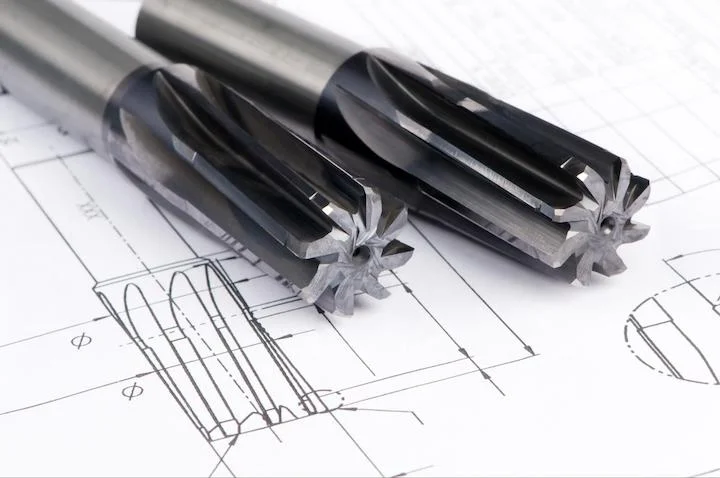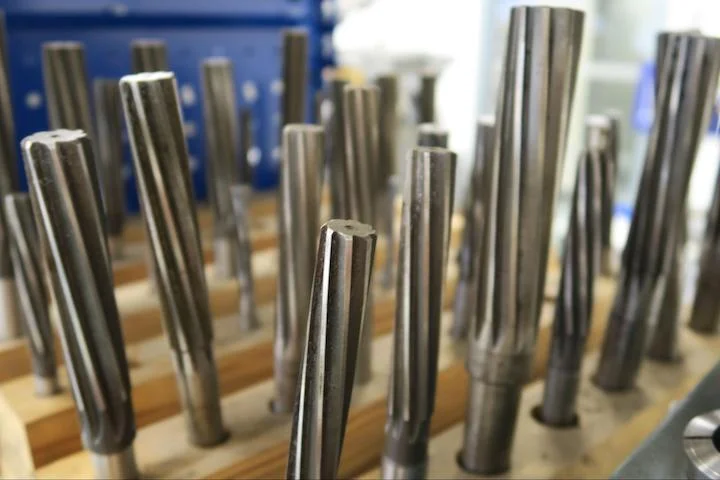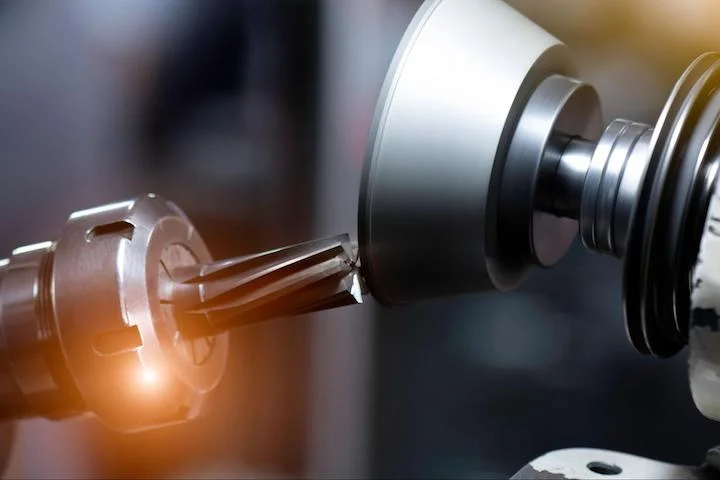Time to read: 5 min
Reamers are finishing tools designed to enhance the precision of a pre-drilled hole while creating a smooth surface finish. Both cylindrical and tapered holes can be produced with reamers. Reamed holes are required for precision applications such as tool and die making, combustion engine parts, airframe fastener holes, and firearms.

This article will describe what reamers are, how they work, the different types of available reamers, and how to use them to achieve unparalleled precision effectively.
What Are Reamers and How Do They Work?
When a hole is needed in a part, it is usually cut with a drill. However, drills do not produce precisely sized holes, as their primary function is to remove large amounts of material as quickly as possible. Drills are ideal for holes that do not need precise sizes and smooth surface finishes, for example, holes for fasteners.
Reamers, conversely, are used to enlarge an existing drilled hole to a precise size with a tight tolerance. Reamers are only designed to remove a small amount of material and typically have straight or helical flutes. Reamed holes can be produced manually or with a machine. Machine-produced reamed holes are preferred if maximum precision is required.
Reamers can be made from HSS (High-Speed Steel), carbide, and high-alloy steel. Hole reaming is considered a finishing process.

Different Types of Reamers
Different reamers are available, each with its optimal use case. Some of the more common reamer types are listed below:
Chucking Reamer
These reamers are the most commonly used and have either a straight or Morse tapered shank. Chucking reamers are sometimes also called machine reamers. The flutes on chucking reamers can either be straight or helical. These reamers are often fixed into a CNC or manual drill press, lathe, mill chuck, or collet, hence the name. The tip of the reamer typically has a 45-degree chamfer. A chucking reamer is utilized to increase the size of an existing drilled hole, to a more precise dimension with tighter tolerances.
Hand Reamer
Hand reamers are designed to be used manually without the aid of a machine, so not with CNC machines. The rear end of the reamer shank is square so it can engage with a tap wrench or spanner. The reamer is slightly tapered at the front to allow it to self-align in the hole, making it easier to use. Hand reamers are ideal for light-cutting jobs and are not as precise as machine reamers due to the potential for human error; therefore, they are not recommended for applications requiring tight tolerances.
Shell Reamer
A shell reamer usually has a hollow cylinder geometry and straight flutes and is utilized on both CNC and manual machines. Helical and twisted flutes are also utilized. The internal diameter of the reamer is sized to fit over an arbor. Quick replacement benefits shell reamers versus standard reamers, as only the cutting edges need to be replaced, not the entire shank. Spinning during reaming is prevented due to the slots on the rear of the reamer, enabling lug engagement on the arbor.
Shell reamers are best suited for holes larger than 0.75” in diameter. Left-hand spiral flutes should be utilized for blind holes.
Ring Reamer
This type of reamer typically has multiple cutting bits attached around the periphery of a ring, resembling a face mill. Ring reamers are utilized at high speeds, mostly for larger diameter holes. Limited expansion, a key design feature of most ring reamers, limits tool wear, resulting in higher accuracy and extended longevity.
Expansion Reamer
Expansion reamers are designed to increase their diameter by turning a screw, which then displaces the cutting edge radially outwards. This expansion allows tool wear compensation and fine control of different hole diameters. The modular design of these reamers, which are not as rigid as standard reamers, can only remove relatively small amounts of material. This means they do not last as long.
Tapered Reamer
Tapered reamers are conical in shape with a specific angle. Tapered reamers are used to create a slight taper in pre-drilled cylindrical holes. Tapered holes are usually required to fit tapered pins for locating purposes or tapered shafts with Morse tapers, a standard taper used for tooling.
Drill Reamer
A drill reamer, also known as a reaming drill, allows for drilling and reaming in the same operation, saving time. A reaming drill is best suited for through-holes. It must be noted that if extremely precise holes are required, a drilling operation with a separate reaming operation is preferable. But, this type of reamer can provide cost savings and streamline the machining process if the precision requirements aren’t too stringent.
Alignment Reamer
An alignment reamer is a powerful reaming tool commonly used in the manufacturing industry to improve holes’ accuracy. It works by enlarging and aligning holes, ensuring they are straight and parallel, which is essential for many mechanical components to function correctly. Due to its precision, the alignment reamer is widely used in machinery and equipment manufacturing, where even the smallest inaccuracies could lead to significant problems. By using an alignment reamer, manufacturers can ensure their products are of the highest quality and meet the strictest standards.

How to Ream a Hole
- Reaming is a multi-step process that starts with drilling a hole.
- The drill size must be slightly smaller than the desired diameter of the reamed hole—in most cases, between 2 and 4% smaller.
- Standard reaming charts indicate the drill size required for a specified reamer diameter. Once the hole is drilled, it can be reamed.
- Ensure the reamer is perfectly aligned with the hole if using a machine to ream.
- If hand reaming, make sure a reamer with a tapered leading edge is used to help align the tool.
- If the reamer has helical flutes, ensure the reamer turns in the right direction.
- Running a reamer in reverse will dull the cutting edge.
- Make sure to use an appropriate coolant during cutting.
- If the hole to be reamed has a discontinuity like a keyway, then a helical reamer is best suited as it can bridge the discontinuity.
Alternatives to Reaming
Reaming is not always the best option for every application. Listed below are potential alternative methods:
- Drilling: High-precision holes are not always required. Sometimes, a drilled hole will produce sufficient precision for the required application. For example, a fastener hole does not need a precise diameter if the fastener is only performing a clamping action for an assembly.
- Boring: A single-point cutting tool is used to enlarge the internal diameter of an existing hole. This operation is typically performed on a lathe but is also possible on a mill if a boring head is fitted to the spindle. Bored holes do not have the best surface finish.
- Honing: Honing uses an abrasive tool to remove a small amount of material from the internal surface of an existing hole. Honing can achieve high levels of dimensional precision and surface quality.
What Materials Can You Ream?
Reamers are typically only used on metals and are not compatible with plastics. The plastic will deflect away from the reamer, resulting in an inaccurate hole diameter.
How to Choose the Correct Reamer
Choosing the correct reamer for your application can be challenging as it depends on several factors. A straight-fluted hand reamer will be ideal if a one-off reamed hole is required. However, a machine reamer is better suited for maximum precision and productivity.
A ring or shell reamer is ideal for high-production-volume reaming of large-diameter holes. Create your free Fictiv account and request a CNC machining quote today — we machine complex parts at ridiculous speeds!









